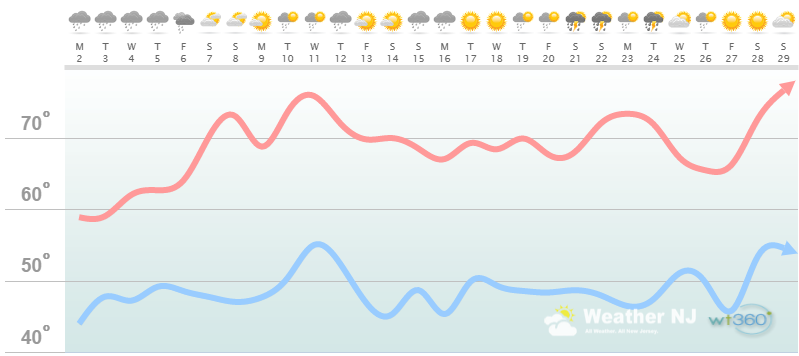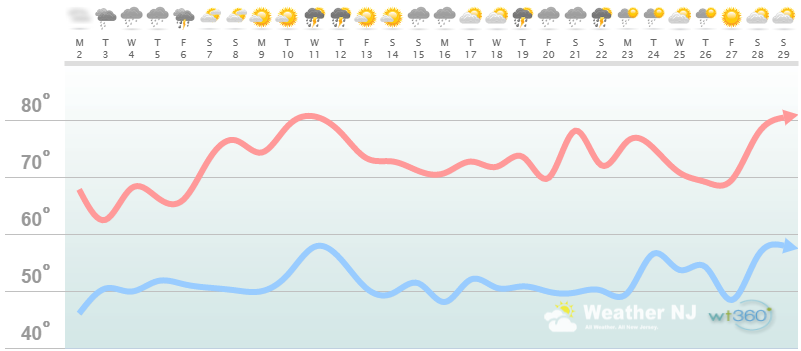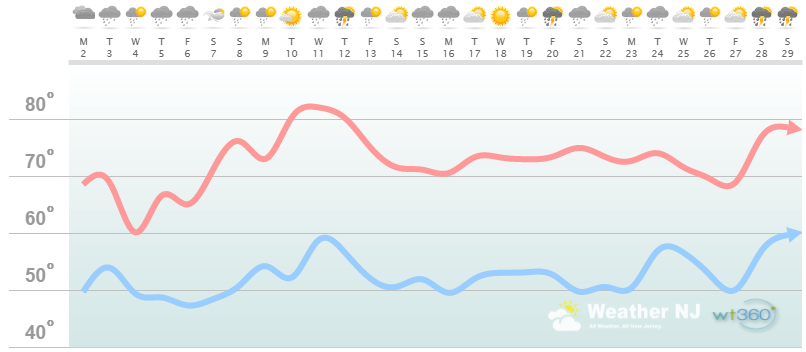Long Range Outlook: Through May 2016

It’s time to harness the WeatherTrends360 proprietary weather algorithms to see how the rest of May 2016 should play out. But first lets break New Jersey into proper climatological regions. We have the higher elevations of NNJ/NWNJ, the interior coastal plain (SWNJ through CNJ and into NENJ), and the coastal regions (most of SENJ). I’ll be representing each climatological region with a 28-day graph from weathertrends360 data followed by a brief discussion. Please keep in mind that these algorithms are documented with an 84% verification rate and are based on oceanic water cycles and time table series. Do not focus on specific detailed daily forecasts (sun vs clouds, etc). Focus on general trends (cool vs warm, rainy vs dry, etc). That’s what WeatherTrends360 does best.
Higher Elevations of NNJ/NWNJ
(Sussex, Warren, Hunterdon, Morris, N. Somerset, and N. Passaic) – Known for little to no Atlantic Ocean influence, colder-snowier winters, and drier conditions in general when compared to the coast. This region is known to get hot when high pressure sits overhead during the summer and bitterly cold during Arctic outbreaks in the winter.
Higher Elevation Discussion: The graph visually represents the first week of May with cooler temperatures and wet conditions. This is all due to the slow moving upper-level low and unorganized weak low surface pressure beneath that will crawl through our region. We need to give it into this weekend for it to all move out. After that, we’ll appear to get stuck in a warmer pattern with temperatures ranging from upper-60s to lower-70s almost every day of the month. The 8th-12th looks a little warmer than the rest of May due to a summer-like Bermuda high placement (southerly flow). Temperatures also look to soar towards the end of the month heading into June. Precipitation appears to be above-average with ample thunderstorm potential throughout the entire month. This should help with drought status.
Interior Coastal Plain from SWNJ-CNJ-NENJ
(Salem, Gloucester, Camden, W. Burlington, Mercer, W. Monmouth, Middlesex, S. Somerset, Union, Essex, Hudson, Bergen, and S. Passaic) – Known for naturally higher temperatures due to lower elevations away from the oceanic influence. This region is also known as “heat island” due to transportation (I-95 corridor), smog, abundant asphalt, concrete, and other man-made substances that naturally absorb and retain heat moreso than natural protected land.
Interior Coastal Plain Discussion: The graph visually represents the first week of May with cooler temperatures and wet conditions. This is all due to the slow moving upper-level low and unorganized weak low surface pressure beneath that will crawl through our region. We need to give it into this weekend for it to all move out. After that, we’ll appear to get stuck in a warmer pattern with temperatures reaching well into the 70s almost every day of the month. The 8th-12th looks a little warmer than the rest of May due to a summer-like Bermuda high placement (southerly flow). There’s a great chance of breaking 80 in this period. Temperatures also look to soar towards the end of the month heading into June. Precipitation appears to be above-average with ample thunderstorm potential throughout the entire month. This should help with drought status.
Coastal Regions of SENJ
(Cumberland, Cape May, Atlantic, E. Burlington, Ocean, and E. Monmouth) – Known for tremendous influence from the Atlantic Ocean. Oceanic influence keeps this zone cooler in the summer and warmer in the winter than the interior coastal plain and especially the higher elevations of NWNJ. This forms a micro-climate that only local inhabitants and frequent visitors are familiar with.
Coastal Region Discussion: The graph visually represents the first week of May with cooler temperatures and wet conditions. This is all due to the slow moving upper-level low and unorganized weak low surface pressure beneath that will crawl through our region. We need to give it into this weekend for it to all move out. After that, we’ll appear to get stuck in a warmer pattern with temperatures reaching well into the 70s almost every day of the month. The 8th-12th looks a little warmer than the rest of May due to a summer-like Bermuda high placement (southerly flow). There’s a great chance of breaking 80 in this period. Temperatures also look to soar towards the end of the month heading into June. Precipitation appears to be above-average with ample thunderstorm potential throughout the entire month. This should help with drought status.
Some extra language I would like to add for the coastal regions involves the natural micro-climate phenomena known as a sea breeze front. This happens primarily due to the hotter surface temperatures inland vs the cooler surface temperatures of the ocean. The interior hotter surface temperatures create lift which pulls air off the ocean to replace the interior rising air. This creates a mini-cold front that backs in off the ocean. It can contribute to fog and even trigger thunderstorms (like a traditional cold front from the W/NW) when there is enough instability present. These thunderstorms are mostly shear-less air-mass thunderstorms and therefore contain downpours with very little movement. I’ll point these out if/when they happen. Right now a sea breeze is mildly offensive as the Atlantic is only 51-52F. In the peak summer its much more pleasant as the Atlantic is in the 70-78 range making the sea breeze feel like natural air condition when it displaces 90F+ conditions. We need to get into June before the coast can escape the unpleasant/colder influence of the ocean. Basically when ocean temps get above 60F.
In English: May is going to be warmer than April as it should be. The first week looks cool and wet but that will change for the rest of the month as we regularly see temperatures in the 70s and 80s. I’m seeing a lot of rainfall and thunderstorm activity which is also normal this time of year. So all in all, a pretty normal May is on tap after a mostly cold and dry April. Be safe! JC
Weathertrends360 is a complete, global, web solution to help retailers and suppliers capitalize on the weather and its influence on sales and marketing plans up to a year ahead. Learn how to become PROACTIVE vs REACTIVE with the weather in every phase of your business – how much inventory to buy/produce, where to allocate more/less, when to run weather-optimized advertising/marketing campaigns – weathertrends360 can help you determine all of this in minutes! 84% independently audited accuracy for both short-term and year-ahead forecasts for temperature and precipitation.
A forecast Weather Trends issued one year ago is more accurate than every other weather company’s 5 to 14-day forecasts. The University of Miami and West Point PhD Climatologist’s prove WTI’s year-ahead forecasts are several times more accurate than NOAA – Click to Download Report. Also check out their free txt and email alerts!
Jonathan Carr (JC) is the founder and sole operator of Weather NJ, New Jersey’s largest independent weather reporting agency. Since 2010, Jonathan has provided weather safety discussion and forecasting services for New Jersey and surrounding areas through the web and social media. Originally branded as Severe NJ Weather (before 2014), Weather NJ is proud to bring you accurate and responsible forecast discussion ahead of high-stakes weather scenarios that impact this great garden state of ours. All Weather. All New Jersey.™ Be safe! JC












